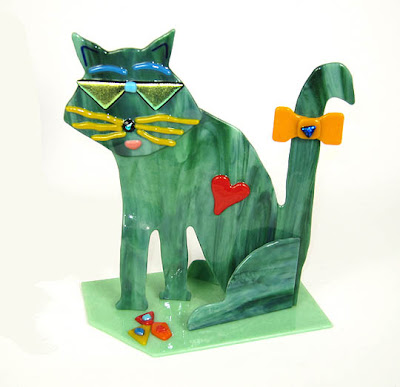 |
| Totem 6 by Tom Philabaum |
Here’s a brief history of the glass art movement, taken from a post from the Milwaukee Art Museum. “Fifty years ago, in 1962, Wisconsin artist Harvey Littleton and glass scientist Dominick Labino introduced glass as a medium for artistic expression in two workshops at the Toledo Museum of Art in Ohio. Littleton and Labino developed small furnaces and a glass formula with a low melting point, making it possible for individual artists to work with glass outside of an industrial setting. In 1963 Littleton taught the first glass-blowing class in an American college at the University of Wisconsin–Madison.
“This combination of events kick-started the American Studio Glass movement and introduced a generation of trained artists to glass as a medium for individual, creative expression. In other words, glass moved out of the factory and into artists’ studios.”
Tom Philabaum is a veteran accomplished glass artist. He built his first glassblowing studio in 1975 in downtown Tucson, and opened a gallery in 1982. Since that time, the Philabaum Glass Gallery has been showing artists from across the country. Tom continues to spearhead the studio of blown glass, and the more current sculptural and site specific art, using a broad array of techniques, including kiln casting, fusing, slumping, and dalle de verre.
At Wilde Meyer, you can see pieces from his Precarious Rock Series. Some have scavo surfaces, a difficult Venetian glass-blowing technique that results in giving a blown glass object the appearance of an artifact dug-up after centuries. (Scavo means unearthed in Italian.) Others in the series celebrate bright color combinations. The precarious notion comes from the fact that the “rocks” are faceted and laminated in seemingly gravity-defying positions.
 |
| Three Heads are Better than Two by Tom Philabaum |
Colores also shows paperweights, vessels and disk sculptures made by Tom, such as Teal Egg, Rock Bowl and Large Jade Disk.
I think that glass artists and collectors are all interested in the effects of different lighting on glass. These changes give glass art life and make it different from two-dimensional work. Sandy Pendleton’s glass pieces have an iridescent quality to them and many textured surfaces that allow light to bounce around. Sandy notes that they change with the light over the course of a day and become more dramatic in the evening. I can see this happening with her “Violet Geology” Bowl and her “Sapphire River” piece.
| Violet Geology by Sandy Pendleton |
 |
| Feather Stone by Sandy Pendleton |
After a lifetime of artistic work in other media, Sue Goldsand discovered fused glass and knew she had found her passion. She likes this medium because it allows her to use strong colors and bold designs to depict her charming animal figures.
Each piece has its own personality. “Teets”, her colorful bird, “Blue Standing Dog” and “Cool Green Cat” are examples of her work.
At Wilde Meyer, Dave glass bowls and display plates are beautiful examples of his proficiency in this medium.
 |
| Yellow Bowl with Red Threads by Dave Klein |
 |
| Waterborn #3 by Dave Klein |
 |
| Rednot by Dave Klein |













